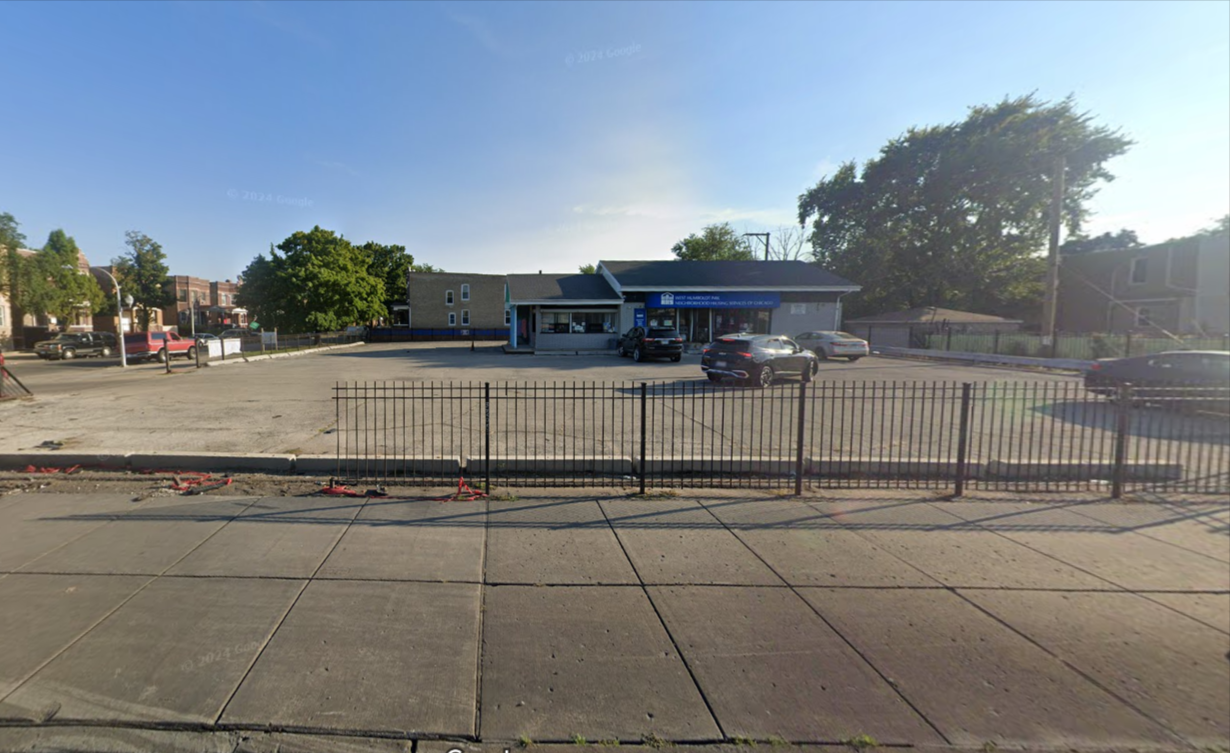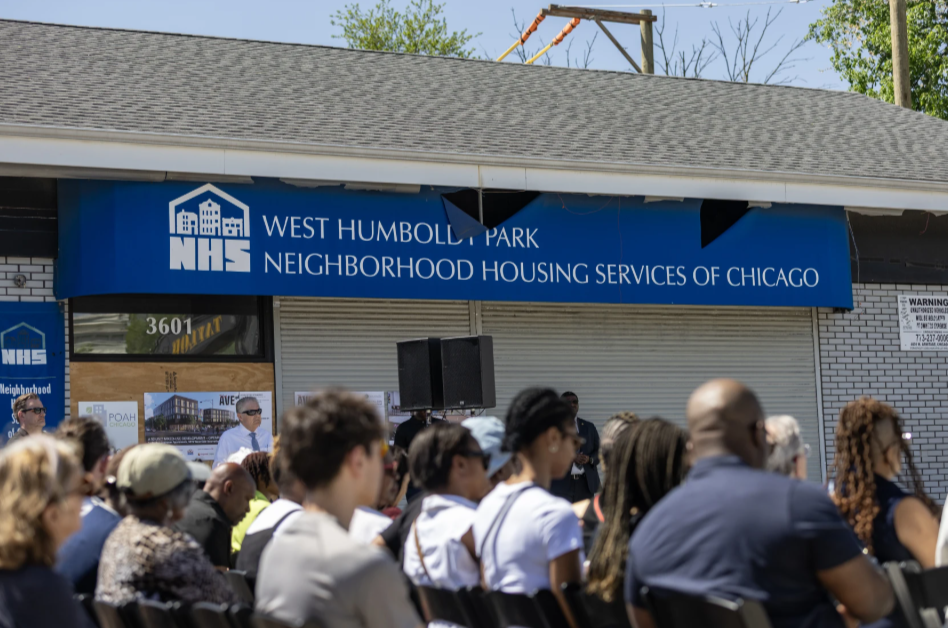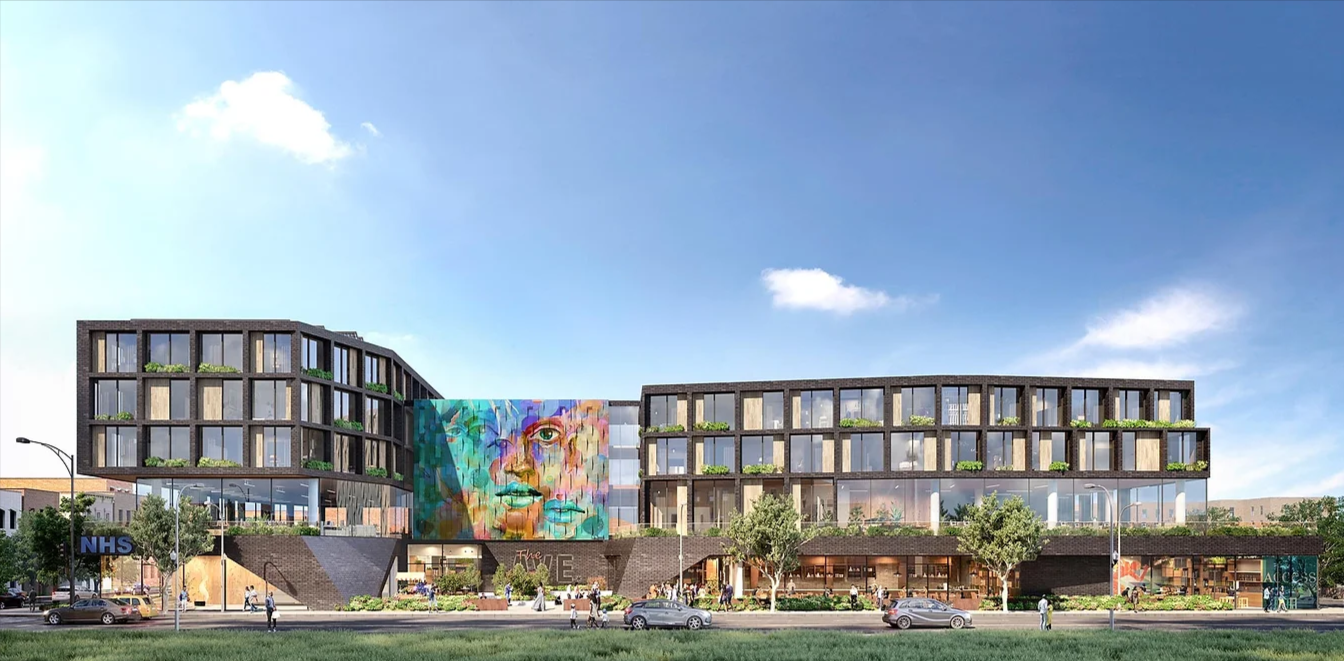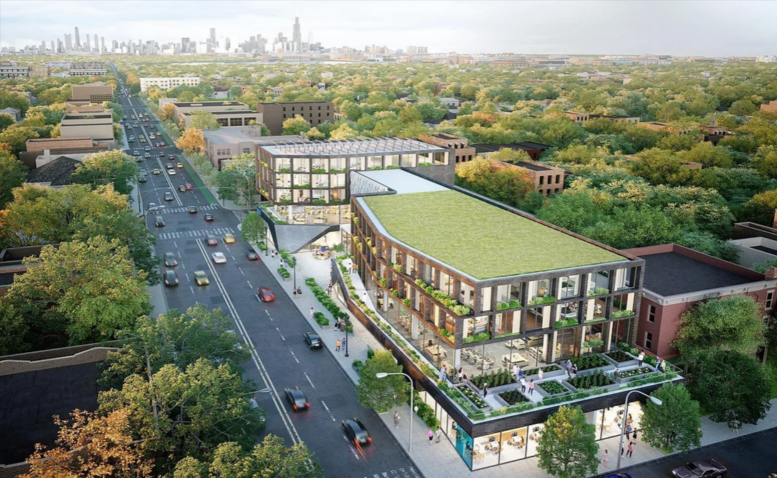A demolition permit has been issued for the single-story building at 3601 West Chicago Avenue in Humboldt Park. The permit comes through more than two months after a new construction permit was issued for The Ave INVEST South/West residential development at this location, the southwest corner of Chicago and Central Park Avenues. The former home of the West Humboldt Park Neighborhood Housing Services of Chicago offices, it was permitted for demolition on May 21. Taylor Excavating is the demo contractor, at a reported cost per the permit of $35,000.

3601 West Chicago Avenue, via Google Street View

A demolition permit was issued for 3601 West Chicago Avenue, seen in this Sun-Times photo from The Ave groundbreaking ceremony. Photo via Jim Vondruska for the Sun-Times

Photo from the groundbreaking ceremony for The Ave, via Leopardo Construction on LinkedIn
A groundbreaking ceremony was held in the WHPN Housing Services parking lot last week.
The permit to begin building the new development was received by co-developers Preservation of Affordable Housing (POAH) and KMW Communities on March 13. Leopardo Construction is on the build as the general contractor of the $45 million project, with design work by the team of Gensler, Nia Architects, and Site Design Group. The four-story building will contain 52 residential units with 30 parking spaces included on the first floor, plus bicycle storage, a residential lobby and mail room, and a community room. The street level will include an outdoor pedestrian plaza along Chicago Avenue.

Rendering of The Ave by Gensler, Nia, and Site Design Group

Rendering of The Ave via KMW Communities
The 3601 demolition permit completes the clearing of the block for redevelopment. The former Chicago-Monticello Medical Center building, which occupied the west end of the construction site at Chicago and Monticello Avenues, was cleared from the site by order of an emergency demolition permit back in 2023.
The West Humboldt Park Neighborhood Housing Services of Chicago will move into new offices in The Ave upon its completion, which POAH and KMW Communities expect to occur in fall 2026.
Subscribe to YIMBY’s daily e-mail
Follow YIMBYgram for real-time photo updates
Like YIMBY on Facebook
Follow YIMBY’s Twitter for the latest in YIMBYnews


So we are building 52 units for $45M, equating to over $865k per unit. Time and time again disappointed by these projects.
While I recognize that affordable housing is often costly to construct, it’s not fair to say that each unit costs $865l to construct in a mixed-use building. The total cost also includes commercial space and office space for the non-profit which will be located there, Residents and Neighborhood Housing Services (NHS). Also, for a catalytic project, one would expect a more expensive facade. This isn’t just another affordable project, after all, but a chance to make a statement in a community which deserves investment.
The problem in that neighborhood isn’t a lack of development. The problem is a scourge of crime. Solving the wrong problem isn’t going to change anything. I know that there are those who say that development will fix the crime–which is the triumph of hope over experience.
There is tons of literature that correlates blight/vacant land to communities on edge and experiencing turmoil.
Simply building won’t solve the world’s problems, but it’s the type that can have immense impacts—another fast food joint versus a grocer like Aldi, a housing project of only Section 8 vs. a Barcelona-style social housing complex. Both provide affordable housing options, but their executions are vastly different.
Vacant land that used to be a proper neighborhood has a longstanding psychological effect that evokes neglect and unrest. When entire neighborhoods are full of blight, emotions build up, and people have a stronger tendency to act up. This can be observed in cities, small towns, or even small rural communities.
I will not comment on the budget aspects of this project, but it will most certainly address crime in some form or another.
Again with Barcelona. You need to visit other cities. But glad to know that the literature supports the idea that turmoil and blight go hand-in-hand. And flooding is associated with water.
But does the blight cause the turmoil? Or does the turmoil cause the blight? I believe it’s the latter. And spending $45M in public funds in a city where private development pops up like mushrooms in safe neighborhoods is misguided. What if that money went towards education, police, job training, or reduction of taxes that overburden our poor and working class?
If the key to eliminating blight was for cities to simply build then we would have solved this problem decades ago. But it isn’t and we haven’t.
And just cause you wanted to be a stickler, here are some other places taking leaps with good design and affordable housing:
– Belgium (Housing Europe)
– Chile (Subsidios para Acondicionamiento Termico de la Vivienda)
– The Netherlands (toegelaten instellingen)
– Mexico (Tu Casa & Vivienda Rural)
There are many examples, but this website won’t allow article links.
If you choose to be ignorant of well-researched subjects, that’s on you. But to be dismissive because it doesn’t support your narrative of blame makes you no worse than feeding disinformation.
Maybe my examples of Barcelona for studying within the city sound like a broken record, but maybe learning a thing or two from an outside source would be beneficial. Clearly, you are upset with the current administration, and Chicago is failing to deliver in a sustainable manner. So, ideas beyond our borders should be considered.
Humboldt Park has possibly 770 vacant lots. That’s 5% of Chicago’s vacant land. East Garfield has 10% and West Garfield has 6%. These numbers in a small pocket account for almost a quarter of the vacant lots within the city. (not by scale of land)
It is foolish to say this area is not at an above-average disadvantage. More can be done, but the private/public partnerships have had a measurable impact. The Hatchery, Garfield Green, and Revolution Workshop will do wonders. The public money already has major private investments sprinkling in, for example, Walmart and the historic mansion at 2678 W. Washington. As the parking lots around the United Center get redeveloped, the improvements will only get more real.
I would love to try things that have worked elsewhere. But instead, Chicago keeps on trying the same things that haven’t worked. Just last week, an idiot on this forum suggested that we turn State Street into a pedestrian mall again. It’s like the old expression goes, “Those who fail to learn from history are too often hack architects who design crappy low-income housing projects”.
So I suggest ideas not done within Chicago, and you turn those down. Then you acknowledge in a sentence but revert to hatting on the same system we both have agreed is not financially sustainable.
A conversation of yelling what doesn’t work without introducing anything to counter what could is as pointless as the boomers in Old Town decrying tall towers shouldn’t be added to their neighborhood. Maybe add to the discussion instead of tearing others down.
For much of the remaining vacant land, it’s been decades since most have had a productive use. The private sector has obviously been unable to make the financials work, so these communities need a little push. The work that’s being done has helped clean up various corners and lots of rehabs have taken place, but the West Side is still hemorrhaging population. Not a single one of the Garfield adjacent neighborhoods have had a positive net increase since the 70’s. At one point, land was going for $1 a lot. So why hasn’t the private sector stepped in and do what it does best?
You answer to that will be to improve safety, we then increase police budgets with money we don’t have, maybe a lawsuit of misconduct takes place costing taxpayers, have the psychology of vacant land still be at play, and after nothing gets built and maybe even more abandoned homes, we are back to square one.
For the record, I wasn’t hatting on anyone.
@Drew, the cost of this project is absolutely ludicrous. I don’t know if you know this area well, but this really is on the edge of Humboldt Park, and an area most people would consider to be Garfield Park. If a generous estimate is made, the cost of a new construction home in this area is at most $500,000 (and the Cook County Modular Home Project is selling homes for $395,000). Instead of building 52 rental units that are below market rate, will never cover the cost of construction, and provide the residents with zero equity, 52 NEW CONSTRUCTION homes could be built and given away, and you’d still have $26,000,000 left over. There is no justification for a project of this cost. Instead, spend the money on infrastructure, crack down on negligent vacant landowners, and adjust zoning where needed to encourage development.
You may want to question where that $45M number came from. If you’ve ever filed a permit you’d know you can put anything down in the project cost est field. And that’s what the author of this article has access to. There are other factors too that could come into play. With that building set back it looks like this could have been a gas station in which case to change it to residential would cost big $ for the cleanup. Even a warehouse has to go through EPA hoops in order to change from manufacturing to residential.
I said I wouldn’t comment on the price tag of the project. I, too, believe we should be doing a lot more bang for our buck. When various private developments are constructing multi-family units for under $300k a unit, we should be replicating those methods 1,000%. I don’t know much if those developers later sell them for much more or just a bit above breaking even. That would need more insight discussing market conditions/location.
As for the other issues affecting the West Side, zoning isn’t the issue. Maybe speeding up the approval is a factor, but most projects reported on this site move swiftly. And there’s plenty of land that doesn’t need a tedious change of use. That can come later once stuff needs redeveloping.
I’m on the more extreme side of thinking it’s foul for people to hold onto land until the price is right. If occupied, fine, but vacant? Up the land tax ten fold. Same goes for downtown parking lot.